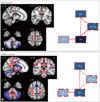Abstract
Background and Purpose
Methods
Results
Conclusions
Figures and Tables
Fig. 1
Regions of interest (ROIs) included in the study. Gray-matter integrity is indicated by blue shading in the respective ROIs, and white-matter integrity is indicated by dashed lines of different styles (none, partly, and full) surrounding and connecting the regions. BSt: brainstem, CB: cerebellum, MCx: motor cortex, Str/Thal: striatum and thalamus.

Fig. 2
Voxel-based morphometry (VBM) and diffusion tensor imaging (DTI) findings for (A) amyotrophic lateral sclerosis (ALS) vs. controls and (B) behavioral-variant frontotemporal dementia (bvFTD) vs. controls. VBM and DTI findings are shown in blue and red, respectively. Colored voxels show regions that were significant in the analysis at p<0.05 with correction for the family-wise error. For all clusters, t>3.50. Clusters are overlaid on the MNI standard brain atlas. BSt: brainstem, CB: cerebellum, MCx: motor cortex, Str/Thal: striatum and thalamus.

Fig. 3
VBM and DTI findings for (A) ALS vs. bvFTD and (B) bvFTD vs. ALS. VBM and DTI findings are shown in blue and red, respectively. Colored voxels show regions that were significant in the analysis at p<0.05 with correction for FWE. For all clusters, t>3.50. Clusters are overlaid on the MNI standard brain atlas. ALS: amyotrophic lateral sclerosis, BSt: brainstem, bvFTD: behavioral-variant frontotemporal dementia, CB: cerebellum, DTI: diffusion tensor imaging, FWE: family-wise error, MCx: motor cortex, Str/Thal: striatum and thalamus, VBM: voxel-based morphometry.

Fig. 4
Threshold-tracking transcranial magnetic stimulation short-interval intracortical inhibition (SICI) results for all groups: across all interstimulus intervals (A) and for the peak interstimulus interval of 3 ms (B). Error bars indicate SEM values. ALS: amyotrophic lateral sclerosis, bvFTD: behavioral-variant frontotemporal dementia, MND: motor neuron disease, SEM: standard error of the mean.

Fig. 5
Results of VBM (A) and DTI (B) covariation analyses for the average SICI. Results for ALS and bvFTD are shown in light-blue/dark-blue and yellow/red shading, respectively. Colored voxels show regions that were significant in the analysis at p<0.05 with correction for the false discovery rate (FDR). For all clusters, t>3.50. Clusters are overlaid on the MNI standard brain atlas. ALS: amyotrophic lateral sclerosis, bvFTD: behavioral-variant frontotemporal dementia, DTI: diffusion tensor imaging, MNI: Montreal Neurological Institute coordinates, SICI: short-interval intracortical inhibition, VBM: voxel-based morphometry.

Table 1
Demographic and clinical characteristics of the study participants

Data are mean±SD values. F values indicate significant differences between groups, *p<0.001. Tukey post-hoc tests were used to compare differences between group pairs.
ACE-R: Addenbroke's Cognitive Examination Revised, ALS: amyotrophic lateral sclerosis, bvFTD: behavioral-variant frontotemporal dementia, CBI-R: Cambridge Behavioural Inventory Revised, n/s: not significant.
Table 2
Parameters used for threshold-tracking transcranial magnetic stimulation in patients with motor-neuron disease (MND), combined frontotemporal dementia (FTD) and MND, and FTD

Data are mean±SEM values. F values indicate significant differences between groups, *p<0.05, **p<0.01.
CMAP: compound motor action potential, CMCT: central motor conduction time, ICF: intracortical facilitation, MEP: motor evoked potential, n/s: not significant, RMT: resting motor threshold, SICI: short-interval intracortical inhibition, TMS: transcranial magnetic stimulation.




 PDF
PDF ePub
ePub Citation
Citation Print
Print


 XML Download
XML Download